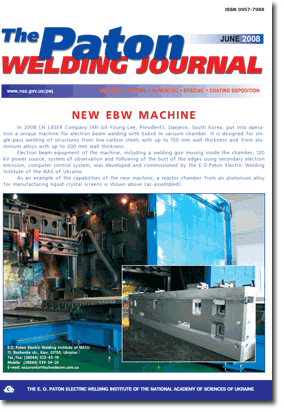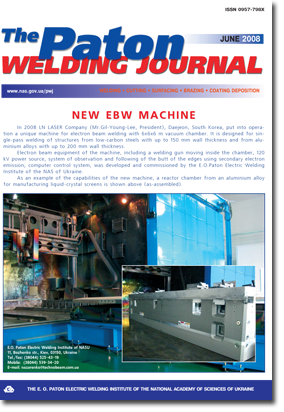

| SCIENTIFIC AND TECHNICAL | |
| Kuchuk-Yatsenko S.I., Zagadarchuk V.F., Shvets V.I. and Gordan G.N. Inlfuence of nonmetallic inclusions in low-alloyed steels on their weldability in flash-butt welding | 2 |
| Influence of nonmetallic inclusions (NMI) contained in low-alloyed steels on joint formation in flash-butt welding was studied. NMI including chemical elements not specified by standards in this steel class were considered. It is shown that presence of such NMI in steel impairs its weldability, particularly, if they contain elements forming refractory oxides. Methods of improvement of flash-butt welding technologies in welding steels with an increased NMI content are outlined. | |
| Makhnenko V.I., Velikoivanenko E.A. and Olejnik O.I. Selection of technologies for repair of defects in active main pipelines | 8 |
| Repair technologies for removal of defects in main pipelines require substantiation for characteristic typical cases of fitness for service. For this, corresponding calculation algorithms are developed to determine the risk of failure of a repaired defect depending upon its size, repair method and operational conditions. The study describes the developed approach by an example of selection of the technology for repair of cracks. | |
| Kharlamov M.Yu., Krivtsun I.V., Korzhik V.N., Petrov S.V. and Demianov A.I. Effect of the type of concurrent gas flow on characteristics of the arc plasma generated by plasmatron with anode wire | 14 |
| Mathematical model is presented, describing the heat and mass transfer processes occurring in interaction of external gas environment with a turbulent flow of the arc plasma generated by plasmatron with an anode wire. Comparative numerical analysis of spatial distributions of heat, gas-dynamic and other characteristics of the turbulent jet of the argon plasma blown about with laminar argon and air flows, as well as emitted into a quiescent gas, was conducted. | |
| Bokota A. and Piekarska W. Modeling of residual stresses in laser welding | 19 |
| Mathematical model and calculation of strains and stresses, occurring in laser welding of a steel sheet, are presented. For determination of the temperature field equation of heat conductivity with a convective term is used, solved by the method of Green function. Model of phase transformations is based on the diagram of continuous cooling of welded steel in Avrami, Koistinen and Marburger equations. When determining temporal and residual stresses depending upon a heat load and phase transformations, connection of thermophysical parameters with temperature and phase composition of steel is taken into account. In the model of stresses structural and transformation strains are taken into account. | |
| Kolodziejczak P. and Kalita W. Quality assessment of laser-welded joints of die-cast magnesium alloys | 25 |
| The paper presents the methods applied for the quality assessment of the magnesium alloy joints obtained by the CO2-laser welding. Die-cast magnesium alloys AZ91 and AM50 have been butt-welded using helium as a shielding gas. | |
| INDUSTRIAL | |
| Albert F., Grimm A., Kageler C. and Schmidt M. Laser-based welding and brazing in automotive production Е investigations to reduce failures and imperfections | 30 |
| Laser welding and brazing are gaining more importance in today`s automotive production. Both methods offer the potential for fast joining processes and a decrease of rework. A robust process management is, however, a precondition to achieve defect-free welding and brazing results. Two research projects are focusing on this problem at the Bavarian Laser Center (Bayerisches Laserzentrum). Solutions for laser welding of zinc-coated steel sheets in an overlap configuration and laser brazing of visible joints are examined. | |
| Pashkov I.N., Iliina I.I., Rodin I.V., Shokin S.V. and Tavolzhansky S.A. Methods of manufacturing and application of rapidly quenched braze alloy | 35 |
| Methods of manufacturing rapidly quenched braze alloys in the form of 0.3Д6.0 mm diameter wire from hard-to-deform materials in the plastic state are considered. Composition of braze alloys on Cu-P, Cu-P-Sn, Cu-Zn-P-Ni base and other systems develop the quasi-eutectic structure containing supersaturated solid solution with distributed phases of copper phosphide as a result of quenching. Examples of application of rapidly quenched braze alloys are given. | |
| Poklyatsky A.G. Characteristic defects in FSW of sheet aluminuim alloys and main causes for their formation | 39 |
| Characteristic defects formed in friction stir welds on aluminium alloy sheets (1.8-2.5 mm) are considered. The effect of the main welding process parameters and different technological factors on formation of these defects was studied. Main causes of lacks-of-fusion, formation of flash and overheating of metal on the weld metal face, as well as lacks-of-fusion in the root part of the welds and formation of defects in the form of discontinuities in their central part were established. Designs of the tools were developed, and ranges of variation of the main process parameters were determined, providing sound friction stir welded joints on aluminium alloy sheets. | |
| BRIEF INFORMATION | |
| Najda V.L., Mozzhukhin A.A., Lobanov O.F., Ignatenko V.A., Olejnik Yu.A., Efimov I.V., Kopylov A.P. and Zakharov A.F. Upgraded equipment for AUST of end sections of pipes | 43 |
| Directions of improvement of the ultrasonic testing automation technology of end sections of pipes of big diameter on acting line production are described. Upgrading is fulfilled with application of a new flaw detector of the NK 363 type, developed in the E.O. Paton EWI Design Office on basis of industrial computer of the ASR 4000 series and five UPSC 3108 MBA eight-channel ultrasonic multiplexers («Socomate», France). | |
| News | 45 |
| NEWS | |
| Exhibition «Welding. Allied Technologies - 2008» in Kiev | 47 |
| Developed at PWI |
24 29 49 |
(You are viewing the simplified file contents)
The cost of subscription/purchase order journals or individual articles
| Journal/Currency | Annual Set | 1 issue printed |
1 issue |
one article |
| TPWJ/USD | 384 $ | 32 $ | 26 $ | 13 $ |
| TPWJ/EUR | 348 € | 29 € | 24 € | 12 € |
| TPWJ/UAH | 7200 UAH | 600 UAH | 600 UAH | 280 UAH |
| AS/UAH | 1800 UAH | 300 UAH | 300 UAH | 150 UAH |
| AS/USD | 192 $ | 32 $ | 26 $ | 13 $ |
| AS/EUR | 180 € | 30 € | 25 € | 12 € |
| SEM/UAH | 1200 UAH | 300 UAH | 300 UAH | 150 UAH |
| SEM/USD | 128 $ | 32 $ | 26 $ | 13 $ |
| SEM/EUR | 120 € | 30 € | 25 € | 12 € |
| TDNK/UAH | 1200 UAH | 300 UAH | 300 UAH | 150 UAH |
| TDNK/USD | 128 $ | 32 $ | 26 $ | 13 $ |
| TDNK/EUR | 120 € | 30 € | 25 € | 15 € |
AS = «Automatic Welding» - 6 issues per year;
TPWJ = «PATON WELDING JOURNAL» - 12 issues per year;
SEM = «Electrometallurgy Today» - 4 issues per year;
TDNK = «Technical Diagnostics and Non-Destructive Testing» - 4 issues per year.


